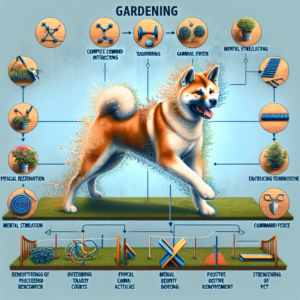Contents
Introduction
Providing a balanced and nutritious diet is one of the most important aspects of maintaining your Akita dog’s health. A proper diet helps maintain a healthy weight, supports muscle and bone health, and provides the energy needed for their active lifestyle. The Akita is a large, strong, and energetic breed, and their diet must reflect these needs. In this article, we’ll explore the essential components of an Akita’s diet, guidelines for portion control, how to choose high-quality dog food, and any special dietary considerations for this breed.
Dietary Requirements
Akitas are known for their strength, endurance, and independence, which are traits that directly influence their dietary needs. Their nutritional requirements are based on factors such as age, activity level, and overall health.
1. Protein
Protein is the most essential nutrient for Akita dogs. As a large breed with a muscular build, they require a diet that is high in quality protein to support muscle growth, repair, and overall body function. Protein should make up around 25-30% of their diet.
Sources of Protein: Look for meat-based proteins like chicken, beef, lamb, or fish as the first ingredient in your dog’s food. These high-quality sources of protein provide amino acids that are essential for muscle maintenance and immune function.
2. Fat
Fat is another critical nutrient that provides energy and supports the absorption of fat-soluble vitamins like vitamins A, D, E, and K. Akitas require moderate fat levels, typically ranging from 8% to 15% of their diet, depending on their activity level.
Healthy Fats: Opt for animal fats like chicken fat or fish oil, as these provide omega-3 and omega-6 fatty acids, which promote a healthy coat, skin, and heart.
3. Carbohydrates
Carbohydrates are a great source of energy for Akitas, especially for active dogs. However, their carbohydrate intake should be moderate and from healthy, digestible sources.
Good Sources of Carbohydrates: Sweet potatoes, brown rice, and barley are great sources of complex carbohydrates that provide steady energy without causing spikes in blood sugar.
Avoid Low-Quality Fillers: Avoid dog foods with excessive grains like corn, soy, and wheat, as these can be harder to digest and may lead to gastrointestinal issues.
4. Vitamins and Minerals
Akitas, like all dogs, require a variety of vitamins and minerals for healthy growth, immune function, and overall well-being. Key nutrients include vitamin A, B-vitamins, vitamin D, calcium, phosphorus, and magnesium.
Bone Health: Make sure your Akita’s food includes a proper calcium-to-phosphorus ratio (typically 1:1 to 2:1) to support bone health, especially as they age and grow.
Joint Health: For large breeds like Akitas, it’s important to include glucosamine and chondroitin in their diet to support joint health and prevent hip and elbow dysplasia.
Portion Control
Portion control is essential to ensure your Akita maintains a healthy weight. Overfeeding can lead to obesity, which is a common issue in large breeds and can lead to serious health problems such as joint issues, diabetes, and heart disease.
1. Determining Portion Sizes
To determine the right portion size for your Akita, consider their age, weight, activity level, and metabolism. The general guideline is to feed adult Akitas 2-3% of their body weight daily. For example, if your Akita weighs 100 pounds, they should be eating approximately 2-3 pounds of food per day, split into two meals.
- Puppies: Akita puppies require more frequent feedings (3-4 meals a day) as they grow quickly. Their portion sizes should be based on their weight and the guidelines provided by the food manufacturer.
- Active Dogs: If your Akita is highly active (e.g., regularly engaged in rigorous exercise like hiking or agility training), they may require more food to meet their energy needs.
2. Risks of Overfeeding
Akitas are prone to gaining weight, especially if they are overfed or not getting enough exercise. Signs of weight gain include difficulty feeling their ribs, a visible fat layer over the ribs, and a lack of a defined waistline. If your Akita is gaining weight, consider adjusting portion sizes, switching to a lower-calorie food, or increasing their physical activity.
Using a Measuring Cup: Always measure your dog’s food using a standard measuring cup to avoid overfeeding. Avoid free feeding (leaving food out all day) as it leads to overeating.
Choosing High-Quality Dog Food
Selecting high-quality dog food is essential to provide your Akita with the nutrients they need to thrive. Not all dog foods are created equal, so it’s important to choose brands that focus on the nutritional needs of your specific breed.
1. How to Read Dog Food Labels
When shopping for dog food, make sure to read the ingredients list and ensure it meets the following criteria:
- Named Animal Protein as First Ingredient: The first ingredient should be a named animal protein (e.g., chicken, beef, or lamb) rather than vague terms like “meat” or “poultry.”
- High-Quality Fats: Look for healthy fats like chicken fat or fish oil.
- Limited Fillers: Avoid foods with fillers such as corn, soy, and wheat. These ingredients are often used to bulk up the food but provide little nutritional value.
- Whole Grains and Vegetables: Healthy sources of carbohydrates and fiber, such as sweet potatoes, peas, and brown rice, should be listed.
2. Consulting a Veterinarian or Nutritionist
For customized feeding plans, especially if your Akita has special dietary needs, it’s always a good idea to consult with a veterinarian or a canine nutritionist. They can recommend a diet plan based on your dog’s individual health conditions, activity levels, and age.
Special Dietary Considerations
Some Akitas may have specific dietary needs or health concerns that require modifications to their diet. These considerations can range from food allergies to specific health conditions that affect large breeds.
1. Food Allergies and Sensitivities
Akitas, like other dog breeds, may be prone to food allergies. Common allergens in dog food include beef, chicken, soy, and dairy. If your Akita exhibits signs of food allergies, such as itchy skin, ear infections, or gastrointestinal distress, consult with your veterinarian to identify potential allergens and select a hypoallergenic dog food.
2. Managing Dietary Restrictions
If your Akita has health conditions like hip dysplasia, heart disease, or obesity, you may need to adjust their diet. For example, joint supplements containing glucosamine and chondroitin may be necessary for Akitas with joint problems, while a lower-fat or weight management food may be needed for overweight dogs.
Transitioning Diets: When changing your Akita’s food, it’s important to transition gradually to avoid digestive upset. Mix the new food with the old food, gradually increasing the proportion of the new food over a week.
Conclusion
Feeding your Akita a balanced and nutritious diet is crucial to their overall health and well-being. By understanding their specific dietary needs, practicing portion control, and selecting high-quality food, you can ensure your Akita leads a long, healthy life. If your dog has special dietary considerations, always consult with a veterinarian to develop the best plan. With the right food and care, your Akita will thrive and be able to enjoy an active, energetic lifestyle.


